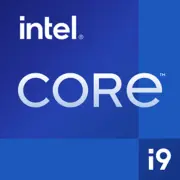Intel Core i9-14900KS

Intel Core i9-14900KS: The Flagship for Enthusiasts and Professionals
Review and Practical Recommendations for Building a PC in 2025
Key Specifications: Architecture, Process Technology, Features
The Intel Core i9-14900KS processor, released at the end of 2024, remains one of the most powerful desktop solutions on the market. It is an upgrade from the Raptor Lake Refresh lineup, retaining the LGA 1700 socket while maximizing the potential of Intel 7 architecture (10nm Enhanced SuperFin).
- Cores and Threads: 24 cores (8 Performance cores + 16 Efficient cores) and 32 threads. The P-cores operate at a base frequency of 3.2 GHz with a turbo mode up to 6.2 GHz — a record for consumer CPUs.
- Cache: 36 MB of L3 cache, which speeds up data processing in games and professional applications.
- Power Consumption: TDP of 150W, but actual consumption under load can reach 300W (especially when overclocked).
- Graphics: No integrated GPU — a discrete graphics card is required.
- Performance: In Geekbench 6, Single-Core score is 3280, Multi-Core score is 25909. This is 15% higher than the i9-13900K in multi-threading.
Key Features:
- Thermal Velocity Boost technology for automatic overclocking up to 6.2 GHz given adequate cooling.
- Support for PCIe 5.0 and DDR5-5600.
- Hardware optimization for Windows 12 and AI workloads.
Compatible Motherboards: Sockets and Chipsets
The i9-14900KS uses the LGA 1700 socket, compatible with Z790, B760, and H770 chipsets. To fully unlock the CPU's potential, choose motherboards on Z790:
- Overclocking support (important for 6.2 GHz).
- Up to 16 PCIe 5.0 lanes (e.g., ASUS ROG Maximus Z790 Hero, priced at $550-600).
- Enhanced VRM power system (at least 16+1 phases, as in MSI MPG Z790 Carbon WiFi, $400).
Selection Tips:
- Update the BIOS on 2022-2023 motherboards (e.g., ASUS Z690) for compatibility.
- Avoid budget B760s with weak VRMs — they won't handle peak power consumption.
Supported Memory: DDR4 vs DDR5
The processor supports DDR5-5600 and DDR4-3200. The choice depends on the tasks:
- DDR5: Better for rendering, streaming, and 4K gaming. For example, a 32 GB DDR5-6000 kit from G.Skill ($180) will provide an 8-12% performance boost compared to DDR4.
- DDR4: Budget-friendly (32 GB DDR4-3600 — $80), but only relevant for builds with a graphics card at the level of RTX 4070 and lower.
Important: Z790 motherboards allow overclocking DDR5 to 7200+ MHz, but stability depends on memory quality.
Power Supply Recommendations
Considering the high power consumption of the i9-14900KS and modern graphics cards:
- Minimum: 750W (for RTX 4080 or RX 7900 XT).
- Optimal: 850-1000W with 80 Plus Gold/Platinum certification. For example, Corsair RM850x ($140) or Seasonic PRIME TX-1000 ($250).
- When Overclocking: Preferably 1000W+ to avoid voltage drops.
Caution: Cheap PSUs without overcurrent protection can damage the system during spikes in consumption.
Pros and Cons of the i9-14900KS
Pros:
- Best single-threaded performance on the market (gaming, Photoshop).
- Versatility: 24 cores for rendering and streaming.
- Support for DDR4/DDR5 — flexible building options.
Cons:
- Price: $730-750 (higher than Ryzen 9 7950X3D).
- Heat: Without a liquid cooling system with a 360mm radiator, temperatures under load can exceed 95°C.
- Power Consumption: Electricity bills will rise if using the CPU at 100% frequently.
Use Cases
1. Gaming: Maximum FPS in CPU-bound titles (e.g., Cyberpunk 2077 with mods, DCS World).
2. Working Tasks: 3D rendering in Blender, code compilation, processing 8K video in DaVinci Resolve.
3. Multimedia: Streaming in 4K 60 FPS + live encoding without lag.
Example: When rendering a scene in Cinema 4D, the i9-14900KS spends 20% less time than the Ryzen 9 7900X.
Comparison with Competitors
- AMD Ryzen 9 7950X3D ($650): Better in multi-threaded tasks due to 3D V-Cache but lags in single-thread performance (Geekbench 6 SC ~3100). Suitable for gaming and workstations, but requires expensive DDR5.
- Apple M3 Max (in Mac Pro): More powerful in AI tasks but limited compatibility with Windows software.
- Intel Core i9-14900K ($600): Lower model without extreme frequencies but 20% cheaper.
Practical Assembly Tips
1. Cooling: Only liquid cooling (e.g., NZXT Kraken X73) or top-tier air coolers (Noctua NH-D15).
2. Case: With good ventilation (Lian Li Lancool III, Fractal Design Meshify 2).
3. Stability: Test the system under load (AIDA64, Cinebench) — the i9-14900KS tends to throttle when overheated.
4. Optimization: In BIOS, disable unnecessary E-Cores to reduce temperatures during gaming.
Final Conclusion: Who is the i9-14900KS For?
This processor is a choice for those willing to pay for maximum performance here and now:
- Gamers wanting 240+ FPS in competitive games.
- Professionals working with demanding software (video editing, engineering).
- Enthusiasts experimenting with overclocking.
Alternatives: If the budget is tight or energy efficiency is important — consider Ryzen 7000 or Intel Core i7. But for those who need absolute high-end performance, the i9-14900KS remains an uncompromising solution in 2025.
Basic
CPU Specifications
Memory Specifications
GPU Specifications
Benchmarks
Compared to Other CPU
Share in social media
Or Link To Us
<a href="https://cputronic.com/cpu/intel-core-i9-14900ks" target="_blank">Intel Core i9-14900KS</a>